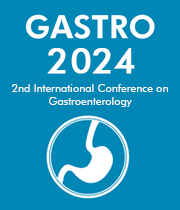Title : Obstructive jaundice in the setting of Ampulla of Vater tumor
Abstract:
Ampullary cancer forms in the ampulla of vater, an opening for CBD and pancreatic duct that enters theduodenum. This type of cancer is fairly rare accounting for less than 1% of all cancers affecting the gastrointestinal tract. 84 y.o. female presented with epigastric pain nausea and vomiting. On admission patient was afebrile and hemodynamically stable. Significant labs included alkaline phosphate which trended from 376 to 109, ALT 120 to 17, AST from 49 to 30, bilirubin was within normal limits and lipase trended from 67 to 42. MRCP demonstrated Intra and extrahepatic biliary dilatation with filling defect in the distal common bile duct and borderline prominent pancreatic duct without definite pancreatic inflammatory change. Gastroenterology was consulted and patient underwent ERCP showing a prominent papilla but otherwise appeared normal. Wire guided cannulation of the common bile duct was done. Stones were not identified in the bile duct on initial cholangiogram. Upon post endoscopic sphincterectomy, abnormal tissue was seen coming out of the bile duct possibly responsible for occlusion. Biopsies were taken which later demonstrated tubular adenoma without evidence of dysplasia or cancer, further EUS did not demonstrate deep extent of the adenoma. However patient was advised yearly follow up for development of malignancy. From an intra-procedure point of view,atypical findings at the ampulla of vater during an ERCP should be biopsied to avoid missing a possible malignancy which can include a benign adenoma to pancreatic malignancy. Even though a tubular adenoma is low risk for malignancy, it should be followed with EUS to check the extent of involvement since deeper invasion has higher association with ,malignant transformation and requires deeper biopsies which guide both management and further serial follow-ups
Audience Take Away:
-
People with atypical findings at the ampulla of vater during an ERCP should be biopsied to avoid missing a possible malignancy which can include a benign adenoma to pancreatic malignancy
-
Even though tubular adenoma is low risk for malignancy, it should be followed with EUS to check the extent of involvement
-
Serial follow ups are necessary given the risk of progression into malignancy



